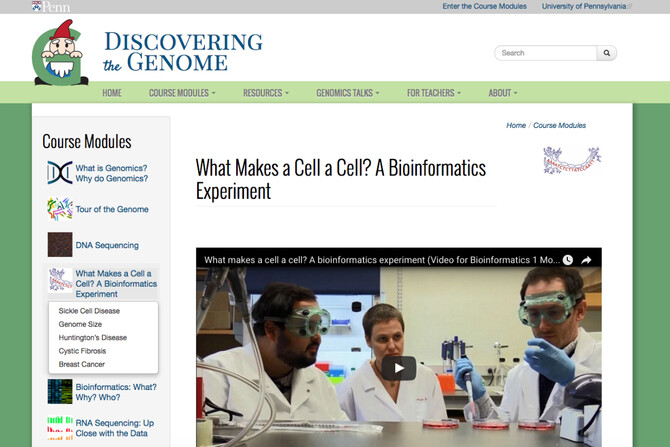Penn’s Genomics Curriculum Makes the Latest Science Accessible to High Schoolers
By Patrick Ammerman
A new University of Pennsylvania effort is bringing genomics into high school classrooms through a free online resource. The goal is to make it easier for science teachers to incorporate the latest advances in science into their curricula.
The initiative, Discovering the Genome, was spearheaded by Kristin Field, director of programs at Penn’s Nano/Bio Interface Center, and Junhyong Kim, professor of biology in the School of Arts & Sciences. Working with researchers around Penn, they have produced a series of video-driven online modules that cover the fundamentals of genomics research. The modules are free, so teachers can easily access what is relevant for their students. While aimed at a high school level, the content could be appropriate for advanced middle school students or even introductory college courses.
A conversation about offering education tools on genomics began in 2010 in the former Penn Genome Frontiers Institute, or PGFI, where Kim served as co-director. As a volunteer coach for his local high school’s Science Olympiad team, he saw that students were eager to learn about genomics, but the biology content they were learning in class was often decades old.
“Everybody hears about genomics all the time,” says Kim. “The students should know something about it, but it’s nonexistent in high school textbooks right now.”
He thought it was important for Penn to help bring genomics into the classroom. With support from the Arthur Vining Davis Foundation, the Discovering the Genome teaching tool was born.
To put together content for the modules, Kim and Field enlisted help from across Penn and beyond in order to provide a true reflection of the frontlines of genomics research. Nearly three dozen graduate students, postdoctoral researchers and faculty from the University community contributed to the finished product in some way, often by being featured in the videos that are part of many of the modules, describing how they currently use genomics in their work and why they were inspired to become scientists.
The website currently hosts seven course modules on topics from high-throughput DNA and RNA sequencing to cell biology to bioinformatics. More modules are still in production. Each is multifaceted, containing practice problems, discussion questions and real-world datasets on which students can perform their own analyses.
In a module on bioinformatics, for example, students are introduced via a brief video to cell biology concepts and how genetic mutations can alter cell function. Then, they are guided through the use of publicly available databases to identify genes that are associated with an increased risk of breast cancer.
Scott Stein, a science teacher at Springside Chestnut Hill Academy, consulted on the development of Discovering the Genome. He has taught genomics in his high school for more than a decade and says his students respond to the topic because it is relevant to their lives.
“They like it because it’s what they see in the news, and it’s meaningful,” Stein says. “It can come down to a personal level if you’re looking at something like, How can I access information about a genetic disorder to see if I’m at risk for it?”
Stein thinks that genomics is especially practical to teach in a classroom setting. Unlike experiments that require expensive lab equipment, many genomics exercises can be done using computational tools available on the internet and incorporating real biological data that has already been collected.
“It makes a lot of sense to have a completely online module that doesn’t require equipment,” Stein says. “That way, the students can basically replicate what researchers are doing.”
An online platform also makes the curriculum accessible to a wide range of classrooms, even those that are under-resourced, a priority for Kim and Field.
“We are packaging it in a way that can reach many more people than a single researcher going into a single classroom,” says Field.
To help orient teachers to the new material and spread the word about the launch, Field helped organize a training last summer. Sixteen teachers met with Stein plus Central High School biology teacher KD Davenport, who also consulted on the project, as well as with researchers from Penn to review the Discovering the Genome modules and how they could be incorporated into the classroom.
At the training, “it seemed like there was enthusiasm about being able to use this component or that component of it,” Field says. “It’s really meant to be a flexible tool.”
There will be obstacles to widely disseminating the material, including the constraints of standardized testing such as Pennsylvania’s Keystone Exams. But, according to Stein, teachers in the workshop recognized that some of the Discovering the Genome modules nicely complemented lessons they were already teaching as a part of the Keystone test curriculum.
“This material gives teachers some more robust examples to help illustrate topics they may have already been covering,” he says.
The Discovering the Genome modules are available online at https://discoveringthegenome.org/.








